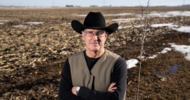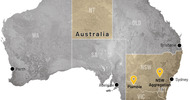Global Pensions | 11 July 2008
by Nicola Horlick
As food prices rise across the world, Nicola Horlick outlines the case for investment in agriculture, with Brazil in particular being ripe for development
Rising world food prices are not only a news story, but a fact of life for us all. According to the UK’s Office for National Statistics, the weekly supermarket shop for British families has seen an increase of 7.8% since last June, while globally it is much more dramatic than that.
According to a report by the OECD and the UN, food prices in the past year have risen more than 20% in China, Kenya and Sri Lanka; more than 18% in Botswana and Pakistan; and between 11% and 14% in Indonesia, South Africa, Egypt, Haiti and Bangladesh. Meat prices jumped 45% in China.
It predicts that between now and 2017, beef and pork prices could be about 20% higher, wheat and corn between 40% and 60% higher, and vegetable oils more than 80% higher. The main reasons for the change have been an increase in international demand for soft commodities such as wheat, rice and grain. This has been partly due to growing populations and partly due to the increase in wealth in countries like China and India where growing middle classes are consuming more, particularly meat.
The growing demand for meat has resulted in an increase in demand for animal feed, which is often grain-based, further driving up the price of grain. The problem has also been exacerbated by drought in some areas, such as Australia, causing poor crop yields.
The increase in demand for biofuels has also seen land normally used to grow wheat or grain being set aside to grow corn for ethanol production. The World Bank pointed out recently that the US’s use of corn for ethanol has accounted for at least 75% of the rise in global corn production over the past three years. Some countries such as Vietnam, India and Japan have caused food prices to spike further by cutting exports to neighbouring countries to protect their own domestic supply. Rising oil prices have further escalated the problem by increasing the cost of production, transportation and food processing.
The role for investors
Investors will have a part to play in addressing the crisis. Far from being exploitative, it is vital that capital pours into agriculture and its related industries, so that the demand for food can be met by increased supply. There are a number of ways of accessing these markets and there has been a substantial increase in activity in commodity futures and also exchange traded funds. Investment in agricultural stocks, such as tractor manufacturers, fertiliser producers and companies making irrigation equipment, is also increasing.
There is also growing interest in agricultural land, which Bramdean Asset Management is looking at and believes has huge potential. Over the longer term, food supply needs to be increased if prices are to come down and this requires either increasing yields from existing farmland or bringing more agricultural land into cultivation for food production.
Land prices in the UK, for example, have already risen sharply as growing confidence amongst farmers has increased demand for commercial arable farms. Prices have also risen as a result of strong demand from buyers who wish to purchase land for lifestyle purposes. According to Savills, the global property and land development agent, the average value of prime arable land across England reached just over £5,000 per acre at the end of the first quarter of 2008. In the US, the average value of farms (all land and buildings on farms) increased by 14% in the year to 1 January 2007 to a record high, albeit to a relatively modest price of US$2,160 per acre.
Brazil moves ahead of the pack
Meanwhile, land in less developed countries is looking very attractive. Eastern Europe offers good quality land at attractive prices, as does South America. We have been looking at Brazil in particular, as it offers good quality land at competitive prices, in an environment which looks politically and economically stable. In Brazil, newly opened frontier land is selling for between $500 and $1,000 per hectare - considerably cheaper than the US or Europe.
Frontier land is land that has not yet been cultivated for production (but not deforested land, I would stress) and it is estimated that there is around 90 million hectares of it in Brazil. Those interested in investing in frontier land would be well advised to make parallel investments in more established agricultural land, which will yield crops while the frontier land is being prepared. Even developed land in Brazil, however, commands prices of between $3,000 and $11,000 per hectare, which is again competitive in the world land market.
Brazil recognises the importance of agribusiness to its economy, particularly as a significant proportion of its exports are from the agriculture business. Brazil’s major agricultural product is soya but there has been growth in other products such as sugar and sugar-alcohol, meat, coffee, cereals and fruit. The Brazilian government is also, unsurprisingly, very much in support of biofuels, as it is the world’s leading exporter of ethanol. Brazil has been an advocate of biofuels since the 1970s and as a result is the second biggest producer behind the US.
Brazilians believe that they have enough arable land for food as well as fuel. Cultivation of sugar cane for ethanol accounts for just 1% of Brazil’s 340 million hectares of arable land. It produces sugar cane-based ethanol, a cheaper product that requires less land and has less ecological impact than corn-based ethanol produced predominantly in the US. Brazil’s overall economy grew at an annual rate of 5.8% in the first quarter of the year, boosted by both a construction boom and high world food prices.
Global financial markets continue to recognise the Brazilian Real and in June 2008, Standard & Poors and Fitch upgraded Brazil’s long term sovereign debt to investment status, which will make it attractive to a broad range of international institutional investors such as big pension funds. Growth in Brazil has been helped along by consumers with rising incomes and access to credit. A new middle class is developing with the introduction of welfare support programmes and increases in the minimum wage.
It is now possible for those living on the poverty line to improve their living conditions and gain access to the middle class. Brazil’s growing middle class provides an easily accessible market for food crops and also ethanol products. Brazil is serious about biofuels; currently all gasoline in Brazil contains 25% biofuel and 80% of new cars run purely on ethanol, providing investors with an income on the doorstep. Brazil also has plans to push into producing biodiesel for trucks and buses. Moreover, Brazil is well placed to supply the US with both food and ethanol to meet its biofuels targets. Currently, the US imposes tariffs on Brazil’s sugar-based ethanol exports to protect its own corn-based ethanol market.
However, US Republican candidate, John McCain, has recently announced that he supports ending subsidies for US ethanol production and applauded Brazil’s drive to find clean energy sources. The pressure is mounting to remove protectionist subsidies and tariffs in developed nations around the world. Clearly it is not practical for most investors to become farmers to take advantage of these opportunities. Instead, there is a growing number of large scale agricultural businesses whose expertise can be harnessed by professional investors in forming strategies to secure exposure to these markets.
Investment in agriculture is certain to grow over the coming years, as a product of supply rushing to meet demand. As well as being a good opportunity in its own right, it is also a welcome opportunity to further diversify investment portfolios, particularly at a time when institutional investors are taking a greater interest in uncorrelated, long term asset streams. For financial advisers and their clients, there will also be a growing number of accessible routes into the market, whether it be in pooled funds or exchange traded commodities, which mean that the opportunities will not only be accessible to the large professional investor, but also to smaller investors.
Agriculture: an investment growth story
- Tags: Brazil
-
 Global Pensions
Global Pensions
- 11 July 2008
Who's involved?
Whos Involved?
13 May 2024 - Washington DC
World Bank Land Conference 2024
Languages
- Amharic
- Bahasa Indonesia
- Català
- Dansk
- Deutsch
- English
- Español
- français
- Italiano
- Kurdish
- Malagasy
- Nederlands
- Português
- Suomi
- Svenska
- Türkçe
- العربي
- 日本語
Special content
Archives
Latest posts
-

HAGL raises $51mln from private placement
- VNN
- 22 April 2024
-

Pakistan sweetens terms to lure Saudi investment
- Tribune
- 20 April 2024











